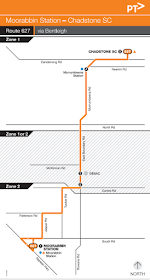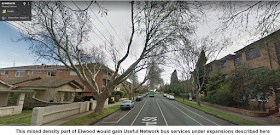However there were instances where they were not. Especially on Sundays when two buses would appear at once, followed by a long gap to the next service. Not because of traffic, but because of timetabling.
When it's busy, like when people finish shopping at Chadstone, people wait more than necessary because of this. Especially retail workers who, unlike shoppers, can't easily time their departure. When it's quiet, like Sunday evenings, we see two almost empty buses following each other. Neither situation is good for service, patronage or efficiency.
This happened because Route 627 got introduced over the top of an existing network that had no changes to its routes or timetables. If you have one route operating every 40 minutes and the other operating every 60 minutes you can't space trips evenly. That's the Sunday situation with the 627 and 822.
The annotated and merged PTV local area map below shows some bus network issues in the Bentleigh East, Moorabbin and Cheltenham areas. There's also spill-over into the Hampton and Sandringham area as both areas share some routes.
Existing Useful Network
So much for broader network issues, what about the existing Useful Network? I explain the Useful Network concept here. It's those routes that are frequent enough and run over long enough hours to be useful for many trips. I've specified a 20 minute frequency on weekdays and 7 day service until 9pm. In other words the coloured lines on the Melbourne Public Transport Frequent Network map with the 20 minute frequency selected.
The map below shows the existing Useful Network (click for better clarity).
East-west Useful Network routes in the area are on main roads, eg North Rd (Bus 630), Centre Rd (Bus 703) and South Rd (824). These are spaced about 1.6km apart and align well with train stations.
Unfortunately the north-south Useful Network is sparse. The central part of Bentleigh East has no routes or legible combinations that meet the standard, with walks of nearly 2km to either the Frankston train line or Warrigal Rd (903 SmartBus), with only infrequent access to Chadstone. The jobs areas in Moorabbin around Chesterville Rd and Bay Rd between Sandringham and Southland also miss out.
What if you wanted to do better? That is to give more people useful bus services without a bucket more buses or money. Today we'll try this exercise for Murrumbeena, Bentleigh East, Cheltenham and adjacent areas.
Unlike other series I'll suggest two expanded Useful Networks. The first is a lower change/lower benefit option that keeps the new Route 627. Whereas the second is a greater change/greater benefit option that merges 627 and 822 to form a major new north-south Chadstone - Southland route.
Expanded Useful Network 1: Bentleigh East boost with Route 627 retained
This option delivers a two route frequent service between Chadstone, Murrumbeena and Bentleigh East. It retains the new route 627 on its existing alignment and service level. Route 822 retains its service level, gets moved to East Boundary Rd and is renumbered 628. The result is a 627/628 corridor with an even 15 minute frequency on weekdays and a 20 minute service on weekends. The simpler service through the heart of Bentleigh East gives better access to Murrumbeena Station and Chadstone, as you can see on the map below.
Route 822's shift and renumbering affects where other routes go. This reshuffling is needed to retain service near all stops currently served.
Route 701 is less used than other local bus routes. It also overlaps Route 767 in some areas. The network above shifts it to Marlborough St to replace Route 822. By serving the busier Oakleigh station (rather than Murrumbeena) it provides connections to Monash Medical Centre from a wider area.
Route 701's occasional Moorleigh deviation gets removed. That means consistent trips with no confusing footnotes on timetables. As compensation Moorleigh gain a regular 7-day service with a minor change to Route 767.
This network hardly changes route kilometres. Neither are there frequency increases on individual routes. Similar annual service kilometres should mean similar operating costs to today. However the simpler direct routes and new frequency corridor should make buses more useful and boost patronage, particularly in Murrumbeena and Bentleigh East.
Expanded Useful Network 2: Bentleigh East and beyond upgrade
Here's a more radical network. It's simpler. There's fewer routes. But they're more frequent. And it brings a Useful Network standard of service near thousands more people and jobs. If you want buses to be simple, direct and more like trams then this is your network. See it below:
The centrepiece is a new route from Chadstone to Southland Station. I call it the 620. It's basically an amalgamation of Routes 627, 822 and part of 767. Designed to get people to trains at Murrumbeena and Southland, shops at Chadstone and Southland and jobs at Moorabbin, it can serve diverse trips all day every day. Service is every 20 minutes Monday to Sunday. Extra short trips could operate from Bentleigh East to Murrumbeena Station to provide a 10 minute peak combined frequency if resources allow.
Bay Rd is the other major Useful Network extension. It is formed by routing 828 to Sandringham via Southland Station and Bay Rd. This direct alignment serves a busy jobs area, improves access to Southland and provides a back up for when either Frankston or Sandringham line trains are disrupted. Because the route is shorter than the existing indirect alignment to Hampton, its operating cost should be less than now. Any savings should be reinvested in frequency upgrades as Route 828 is a popular service.
How are local routes affected? Route 701 can be realigned as per Network 1, ie via Marlborough St. Route 767 is similarly changed except for running down Rowans Rd (to replace the existing 822, or Network 1's 628).
Running 828 to Sandringham and replacing 822 with other services creates some gaps in the Hampton - Highett - Cheltenham area. A new route 707 from Hampton to Southland via Highett and Cheltenham overcomes this. It could serve all stops the 828 does until Highett. Then it runs to Cheltenham (replacing 822) before terminating at Southland. Route 707's 30 minute frequency is designed to mesh with trains at Hampton (every 15 minutes). There is also the option of an even spacing with Route 708 (also every 30 minutes) which starts at Hampton and serves a similar catchment. This is unlike now where spacings between the 708 and 828 can never be even due to unharmonised frequencies.
I haven't done detailed costing calculations. Like Network 1 the weekly service kilometres run is unlikely to be much different from now. The big difference is that unlike Network 1 there are fewer routes. And route kilometres are less. That frees up service kilometres for use on expanded Useful Network routes like the 620.
That spreads benefits much more widely, to include people like Moorabbin residents, Southland shoppers and workers near Chesterville and Bay roads that Network 1 did not benefit.
Oh, and what if you really wanted to keep the 627 that Network 2 scraps? A possibility could be to keep it running simultaneously with the revised network for a month or two to give time for people to try different network options. If patronage drops it could be made an hourly daytime one-bus route to better reflect demand. And if usage is very low then a review could ask the community whether they would prefer other upgrades, such as a Route 823 Nepean Hwy extension to Elsternwick and a compensatory 701 extension to Brighton via Dendy St.
More detail
See the link to Useful Network map if you need more detail. You can also view it below after locating the area and selecting the menu (top left) to show whether you want to see existing or expanded Useful Networks. Top right opens it in another window if preferred.
Conclusion
I have presented two low cost network options for buses in the Murrumbeena, Bentleigh East and Cheltenham areas.
Network 1 uses the recently introduced Route 627 as a starting point for more useful service between Chadstone, Murrumbeena and Bentleigh East. Other areas gain simpler and more consistent services.
Network 2 also benefits Chadstone, Murrumbeena and Bentleigh East. Plus, there are further gains for people and jobs in Moorabbin, Cheltenham and Sandringham. However, in its purest form, the network replaces the 627 with a newer, longer and more frequent route.
What do you think? Which option is best? Or do you have other ideas on the local network?
Please comment below.
PS: Other reading. 1. Daniel Bowen's post on local buses with some history. 2. Krustylink old timetables (822 used to have a 20 min peak frequency).
PPS: An index to all Useful Networks is here.
Please comment below.
PS: Other reading. 1. Daniel Bowen's post on local buses with some history. 2. Krustylink old timetables (822 used to have a 20 min peak frequency).
PPS: An index to all Useful Networks is here.
































